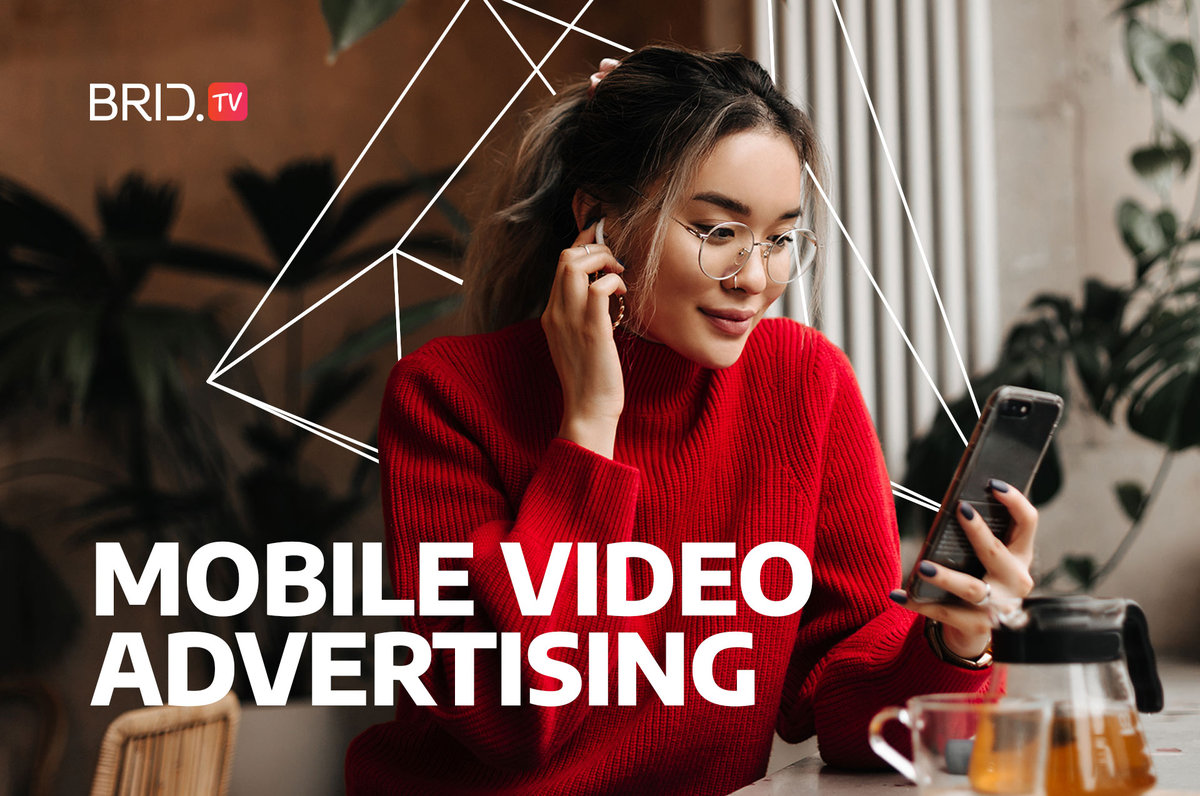Online video has been the king of engagement for a few years now. It offers the most interactive user experience and can keep viewers’ attention longer than other content formats. When you combine that with the fact that 75% of all videos are consumed on mobile devices, it’s easy to see why marketers worldwide turned their attention toward mobile video advertising.
Mobile video is all the rage among millennials, as 98% of 18–34 year-olds watch videos daily on their mobile phones. That number is significantly lower for all other devices!

This growing trend proved to be an excellent opportunity for video content marketing professionals and advertisers targeting millennials to tap into such a lucrative market. Many were quick to capitalize on the opportunity, which is evident by some of the most recent mobile video advertising stats.
According to IAB Europe’s State of Online Video Advertising in 2022 report, more than 61% of digital video campaigns are run on the mobile web nowadays. When you combine that with the fact that more brands are investing in digital video advertising than ever, it’s clear that there’s a lot to gain from it!
But can anyone get on board the mobile phone video advertising train? Yes, they can. But should they? It primarily depends on your target audience and business needs. If you work in an industry where you can reach your ideal consumers through mobile video, you’d be remiss not to try it!
If you’re new to the mobile video advertising world, you will need some guidance. Don’t worry, though. This article will cover all the fundamentals of mobile video advertising to help you get started.
What Is Mobile Video Advertising?
Mobile video advertising entails delivering video ads to users’ phones or other mobile gadgets like tablets. There are different types of mobile ads (e.g., banner ads, text-based ads, videos, minigames), but video ads are the most popular ones.
The primary difference between mobile and traditional online ads is that mobile adverts must be scaled down to fit a mobile device’s smaller screen. However, the incredible reach mobile web video ads have makes the extra effort well worthwhile.
Which Devices Can an Advertiser Target With a Mobile Video?
Mobile ads allow marketers to target consumers they otherwise wouldn’t be able to reach. Mobile app video advertising enables you to deliver ads to mobile devices and tablets of various operating systems and implement contextual and behavioral targeting to zero in on your ideal consumer. These advanced targeting options allow marketers to boost their conversion rates and maximize ROI.
But why is reaching mobile users such a big deal? The reason is simple — it opens up plenty of new marketing opportunities. That is because more people own a mobile device or tablet than a PC. Also, an average consumer spends significantly more time daily on the phone than on a desktop.

Because of the above, digital marketers cannot ignore the lucrative mobile market unless they want to do it to their own detriment.
Effectiveness of Mobile Video Advertising
We’ve already briefly touched upon some of the benefits of mobile video advertising, but there’s still much more to say about the topic. It should already be evident that mobile video ads are an excellent marketing tool — otherwise, they wouldn’t be so much fuss about them! But why is mobile video advertising so effective? Here are a few excellent reasons:
- Mobile Video Ads Are Interactive and Engaging — Videos are incredibly engaging by themselves, but mobile technology offers much more than just traditional video ads. Interactive mobile video advertising runs rampant online! Mobile technology allows advertisers to include interactive video elements or even minigames, making them the most interactive form of advertising on the market.
- They Allow for Precise Targeting — Advertising on mobile devices gives marketers an easy way to collect and use user data to improve ad targeting. They can employ various behavioral or contextual targeting techniques to funnel their ads to the most relevant target audience.
- Mobile Video Ads CPM and Conversion Rates Are High — Video ads have some of the highest eCPM and conversion rates in the online advertising industry, making them an appealing option for advertisers and publishers.
- Better Fraud Protection — Preventing ad fraud on mobile is significantly easier than on desktop. That means publishers can save significant amounts of money by prioritizing mobile advertising.
- It’s Cost-Effective — Marketers can launch a mobile video ad campaign on much lower budgets than a desktop or traditional advertising campaign.
The above reasons should be enough to convince any seasoned marketer to give mobile phone advertising a shot. But before you start, you’ll need to decide which video ad format you’re going to use.
Types of Mobile Video Ads
There are multiple types of mobile video ads marketers will be able to pick from. Your choice will depend entirely on your budget, business needs, and target audience. So take your time and ensure you choose the ad type that best fits your campaign’s goals. Here are five of the most common types of mobile videos ads and who they’re most suited for:
1. Instream Video Ads
Everyone who’s ever visited a website like YouTube is undoubtedly familiar with instream video ads. These are video ads that play before, during, or after watching an online video. Instream video ads are the most widely used type of video ads, primarily due to the popularity of YouTube. This video-sharing website’s incredible growth is why these ads are some of the most lucrative ones in the industry.
YouTube has over two billion active users now, and 40%–50% of them watch videos on their phones.

As you can see from the graph above, when you combine the tablet and mobile users, more than half of YouTube’s viewer base uses it on mobile devices. That is over a billion potential customers!
Also, let’s not forget to mention that while ad blocking software runs rampant on PCs, that is not the case for mobile!
2. Interstitial Video Ads
Interstitial video ads are pop-up advertisements that appear as short video clips covering the user’s entire screen. These ads are often used in various mobile applications in-between menu transitions and are a way to monetize free mobile apps.

Although these ads can be any form of graphic or rich media ad, videos are by far the most effective.
The most notable downside of interstitial ads is that they are quite intrusive. Despite their having high clickthrough rates, you can mostly attribute them to accidental and not engaged clicks. That is why we advise you to use these sparingly, as you can spend your budget better elsewhere.
3. In-App Video Ads
In-app video advertising entails promoting your brand using in-feed videos on various social media apps. These ads appear before users as sponsored videos while scrolling down their feed on platforms like Facebook or Instagram.

These ads are not as effective as instream ads, but they easily trump interstitial ads for a few reasons:
- They blend in with the environment.
- They don’t provide an interruptive user experience.
- In-feed video ads cannot be blocked.
Considering that more than half of the global population uses social media in one form or another, in-app video ads can be an excellent way to build brand awareness or reach various niche audiences.
4. Gamified Video Ads
Gamified video ads are a particular type of interactive mobile video ad that has users play a minigame or interact with the ad somehow. These game-like video ads are one of the best ways to engage consumers. Aside from that, these ads often have high conversion rates, especially when advertising educational or problem-solving apps.
Why are gamified video ads so effective? Because consumers are more likely to stay engaged for longer and convert if they have an exciting challenge (like a puzzle or a riddle) in front of them.
5. Rewarded Video Ads

Rewarded video ads are a widespread mobile ad type that lets users earn a reward for watching a video ad. This ad type is most popular in the mobile video gaming world because it offers an uninterrupted gaming experience and has excellent engagement rates.
Rewarded video ads usually last between 15 and 30 seconds and cannot be skipped. The rewards users can get from these ads vary greatly — from receiving additional lives to discounts and various multipliers.
Mobile Video Advertising Networks
If what we’ve covered so far about mobile phone video advertising made you want to test the water, you’ll likely need some help to get started. The first and most crucial thing you’ll need to do is find a mobile video ad network. Here are five excellent choices:
1. Google Mobile Ads
Although Google deals with both desktop and mobile devices, it is the unprecedented king of digital advertising. Besides some of the industry’s highest eCPM, Google Mobile Ads also offers an excellent variety of mobile ad types, including video ads. This ad network also gives publishers various targeting options and lets them publish ads on Google SERPs, browsers, and apps.
One thing is for sure — you cannot go wrong with Google!
2. Facebook, Instagram, and TikTok Video Ads

Coming in behind Google are social media video platforms like Facebook, Instagram, and TikTok. These platforms have their own advertising spaces and massive audiences. Although they target entirely different online ecosystems, marketers have been leveraging social media advertising for years now.
As of recently, these platforms have expanded and perfected their advertising options to include mobile video. The best part about them is that they support various ad types, including native, interstitial, instream, and even banner ads. That means marketers will have plenty of customization options in their campaigns.
And let’s not even mention that platforms like Instagram and TikTok are specifically tailored to mobile users!
The only potential problem of using social networks in mobile advertising is audience targeting. Some of these platforms have niche audiences, so not all will be suitable for all types of businesses. So do your audience research and targeting before advertising on these platforms!
3. AdColony
This app monetization platform is one of the largest globally and has many large brands like Adidas or Hilton Hotels under its wing. AdColony specializes in rich media and mobile video ads.
One of the most notable advantages of this ad network is that it supports in-app advertising and offers various micro-targeting options some other providers lack. That means brands can take into account their users’ devices (iPad, Tablet, iPhone, etc.), OS (Android or iOS), connection type (Wi-Fi, 4G, etc.), geodata, or content in their ad targeting.
If you are looking for a mobile ad network other than Google, AdColony is likely the best choice!
4. Airpush
Airpush is another well-known name in the mobile advertising industry. This company works with some giants like Coca-Cola, Amazon, and Toyota and serves billions of impressions every year!
Airpush lets advertisers choose between twelve different ad formats and offers a sleek and user-friendly interface, making navigating and tracking your creatives’ success seamless.
5. AppLovin
AppLovin is a mobile ad network that specializes in mobile game monetization. Advertising with AppLovin allows your creatives to reach over 500 million gamers!
This network also offers plenty of features for maximizing monetization, prides itself on its advanced machine learning and predictive algorithms, and offers high-end targeting options.
If your target audience is fond of mobile gaming, there’s no better mobile advertising choice than AppLovin!
You Might Also Like: 20 Best Video Ad Networks for Publishers (and How to Pick the Best One)
What’s the Future of Mobile Video Advertising?
With everything we’ve showcased by now, it’s clear that mobile video advertising is a potent way to market your brand and that the industry is booming. But what lies in the future of mobile video advertising? Is that upward trend sustainable?
Considering just how popular mobile devices are becoming, we believe the mobile advertising industry will only continue to grow. It has proven as the most effective way to reach younger audiences, so more and more brands are sure to enter the market.
With the development of the new 5G technology, mobile internet will become more accessible than ever! That will only further facilitate the growth of the mobile ad market.
Augmented reality in marketing is also becoming more prominent, and mobile platforms are the perfect medium! So sooner or later, this trend is sure to reach the mobile market as well.
Another change that will affect the mobile video industry is the growing number of OTT apps. More and more users are watching videos on their mobile phones in favor of the dying cable TV, making this marketing much more appealing to advertisers. That is why many publishers are leveraging some of the best OTT platforms to reach users across various devices with minimal hassle.
The Future of Mobile Video Ad Formats
But what about mobile ad formats? Is anything going to change?
Experts predict new formats are sure to pop up, primarily due to the rise of virtual reality. As for the existing formats, many believe that the future of mobile advertising lies in native advertising. That’s right — more and more platforms and apps will adopt the approach of social media giants like Instagram and TikTok and have their ads blend in seamlessly with their content. These ads offer the best user experience, and quality UX will be the future of the internet.
Should You Get Started With Mobile Video Advertising?
If our stance on this matter wasn’t clear enough, the answer is yes! Whether you’re a publisher or advertiser, the mobile video advertising market is massive and offers a lot of potential for profit.
Both publishers and advertisers get the opportunity to reach new audiences and be present on the devices their viewers enjoy using. However, while advertisers will only need to find a reliable mobile video ad network to distribute their ads, publishers face a much bigger challenge when entering the market.
Building and launching an ad-supported OTT app from scratch takes a lot of time and money, and not all publishers may be able to afford it. That is where OTT solutions like Brid.TV’s can be invaluable.
Brid.TV’s extensive and regularly updated Android, iOS, and tvOS SDKs allow publishers to integrate the Brid.TV platform and monetization solution with their OTT apps seamlessly. Our SDKs give publishers access to a wide variety of advanced monetization options like video header bidding and ad podding across a variety of OTT devices. That way, publishers don’t need to build any video technology from scratch and can focus their efforts on constructing their app.
Want to learn more about our OTT solutions and how they can help you? Check them out below or get in touch, and our team will answer any questions you may have!


